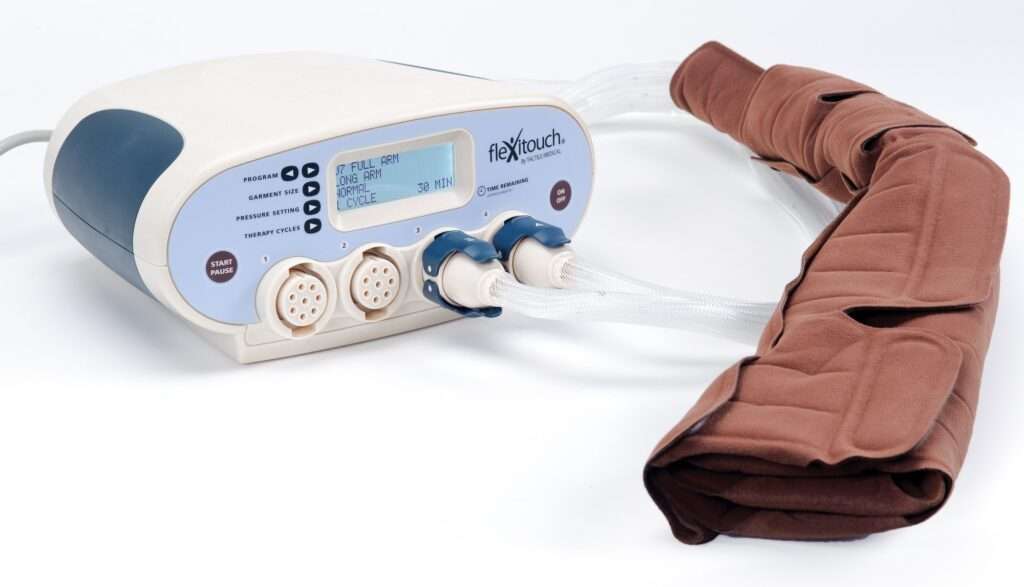Pneumatic Pressure Pump Therapy
Pneumatic Pressure Pump Therapy

A pneumatic pump — also called an intermittent pneumatic compression pump — is a machine that has an inflatable sleeve or vest-like garment attached to it, with multiple chambers (like balloons) that inflate one after the other to stimulate the flow of lymph in the right direction.
Depending on the type of pump used, this would either mean sitting up or lying down. For pumping the arm, you would sit upright in a chair next to the pump and insert your arm into the sleeve, which looks like an arm-length blood pressure cuff. For the chest, or trunk, you may be sitting up or lying down depending on the make of the compression garment, which is like a vest or jacket. Then you would switch on the pump for pumping sessions that could last up to an hour.
Pneumatic compression pumps are proposed as a treatment option for patients with lymphedema who have failed conservative measures. They are also proposed to supplement standard of care for patients with venous ulcers. A variety of pumps are available; they can be single chamber (non-segmented) or multi-chamber (segmented) and have varying design and complexity.
Pneumatic compression devices consist of an inflatable garment for the arm, leg, trunk, or chest and an electrical pneumatic pump that fills the garment with compressed air. The garment is intermittently inflated and deflated with cycle times and pressures that vary between devices.
Cold lasers are handheld devices and are often the size of a flashlight. The laser is placed directly over the injured area for 30 seconds to several minutes, depending on the size of the area being treated and the dose provided by the cold laser unit.
During this time, the non-thermal photons of light that are emitted from the laser pass through the skins layers (the dermis, epidermis, and the subcutaneous tissue or tissue fat under the skin). This light has the ability to penetrate 2 to 5 centimeters below the skin at 90mw and 830 nm.
Once the light energy passes through the layers of skin and reaches the target area, it is absorbed and interacts with the light sensitive elements in the cell. When cells absorb this light energy, it initiates a series of events in the cell that is theorized to eventually result in normalizing damaged or injured tissue, a reduction in pain, inflammation, edema and an overall reduction in healing time by increasing intracellular metabolism.
Benefits of Pneumatic Pressure Pump Therapy
- Stimulating blood and fluid movement
- Relieving pain
- Preventing numbness
- Providing consistent treatment
- Ease of use
- Non-invasive solution
- Feels relaxing
- Minimal side effects
Indication of Pneumatic Pressure Pump Therapy
- Recent surgery, which decreases your mobility and increases inflammation in the body, which can lead to clotting
- Medical conditions that limit your mobility, such as an injury or stroke
- Long periods of travel, which limit your mobility
- Injury to a deep vein
- Inherited blood disorders that increase clotting
- Pregnancy
- Cancer treatment
- Smoking
- Obesity
- Older age
Book Your Appointment with Us Today !
- Chiropractic Services
- Osteopathic Manipulation
- Cupping Therapy
- Dry Needling Therapy
- Kinesiology Tapping Therapy
- Advanced Physiotherapy
- Other Service
- Shock Wave Therapy
- Spinal Decompression Therapy
- Class 4 Laser Therapy
- Scaner Therapy
- P. E. M. F Therapy
- Interferencial Current Therapy
- Short Wave Diathamy
- High and Low Current TENS Therapy
- Ultrasound Therapy
- Russian Current Therapy
- Paraffin Wax Bath
- Physio Gun
- Cold Laser Therapy
- Chiropractic Manual / Electrical Adjustor
- Pneumatic Pressure Pump Therapy
- Pressure Biofeedback Stabilizer Therapy
- Manual Therapy
- IASTM
- Cranial Manipulation
- Visceral Manipulation
- Myofascial Release
- Strain-Counterstarin Techniques
- Muscle Energy Techniques
- Lymphatic Activation Techniques
- Deep Tendon Release
- Diet and Nutrition
- Psychology Counselling
- Speech Therapy
- Employee Fitness Training
- Online Consultations
